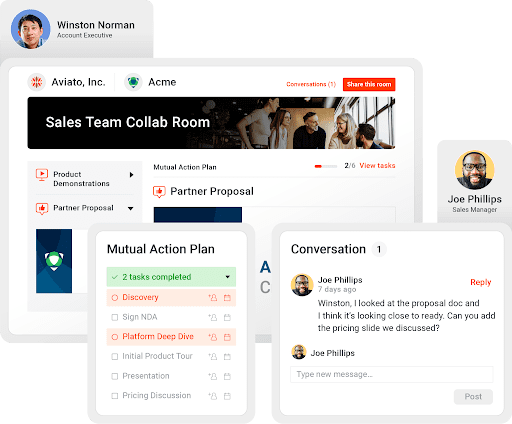Like any sales leader, you work hard to hire and develop a team of reps that will close deals and contribute to revenue growth. But the harsh reality is that your reps aren’t spending much time selling. According to recent research, sales reps spend a mere 28% of their time each week on selling activities.
That certainly doesn’t mean your sellers are slacking off 72% of the time. Instead, they spend the bulk of the week on time-consuming, tedious tasks and administrative work. This frustrates reps and stands in the way of them reaching their full potential.
To increase sales productivity, you must first pinpoint roadblocks and determine what’s eating up your team’s time. Then, you can work to optimize processes and procedures so reps have enough time to effectively tackle revenue-generating activities.
Increasing sales productivity doesn’t have to be a big undertaking. Even a small uplift in the amount of time each rep spends on core selling activities will add up to a big productivity boost across your entire sales team.
Not sure where to start? Read on to explore six practical ways to remove barriers and increase sales productivity across your entire team.
1. Automate data entry
Adding data to your customer relationship management (CRM) program is time-consuming and a top frustration for sales professionals. Fortunately, there are ways to automate data entry so your reps have more time to sell.
As reps work on more complex deals with multiple stakeholders and more touchpoints, each interaction creates more information and data for them to keep track of. It takes a long time to add detailed notes and provide meaningful updates for each sales activity in your CRM.
You need to automate data entry to get data into your CRM faster. Automation also improves data quality by reducing the number of incomplete CRM records — normally a clear sign that a rep started to update their records and then jumped on another call.
Use AI to analyze call recordings, outreach emails, and social media messages, looking for topics discussed, key messaging, or competitors mentioned

Then, connect that AI with your CRM to automatically link to call recordings, other sales activity, and appropriate tags based on the insights it gathers. Using AI to automate data entry enables sellers to spend less time inputting info without compromising data quality.
2. Consolidate tools to reduce context switching
Context switching is where you jump between projects, tools, and tasks — and it affects your productivity levels and focus. For example, Asana found that “workers switch among 10 apps 25 times per day,” greatly reducing their efficiency.
Workers switch between apps up to
For sales organizations, tool overload seems even worse. According to recent research, around 63% of revenue organizations have ten or more tools in their tech stacks. It’s not surprising that 49% of sellers feel overwhelmed by the number of technologies needed to do their jobs.
But it’s also not good, as overwhelmed sellers are 43% less likely to make quota than their peers who aren’t overwhelmed.
Consolidating your sales tech stack can increase productivity by reducing duplicated effort and context switching. According to Forrester, there is a “significant overlap in features and functionality that exists between different sales tech categories.”

Consolidation will bring “greater value for buyers of sales tech, reducing dependency on point solutions.” A closer analysis of your existing tech stack may reveal duplicate functionality across multiple tools — so consolidation will save the business money, as well as help your sales reps increase productivity.
Before you start consolidating tools, sales managers should ask their teams which ones they use most and where they spend the most time duplicating work. This will help you understand the biggest inefficiencies for your sales teams and how your existing tech stack is affecting their workflow.
Then, you can review your existing tools and the functionality you get across each. Look for:
- Overlapping features
- Duplicate functionality
- Opportunities to set up new integrations between tools
- Options to switch to an all-in-one platform instead of multiple disparate applications
For example, Mindtickle’s revenue enablement platform integrates sales enablement, content management, conversation intelligence, and sales coaching. Ken Blank, senior sales enablement program lead at Infoblox, explained, “We’ve been able to integrate multiple disjointed systems into one single platform for our internal customers as well as the enablement team.”
3. Improve access to content and resources
Finding the best content and resources is another inefficiency for many sales teams. Forrester states that “not having the right content” is one of the biggest productivity challenges facing sales teams and that “finding content and information is a significant productivity obstacle.”
Sales teams often struggle because they don’t know what content is available or where to find it in shared drives. Finding sales content can be especially difficult if another team (such as marketing) creates the content, and each team has different ways of organizing assets. You can help sales reps improve their productivity by making it easier to find and use sales content to move their deals forward.

Adopting a dedicated sales content management system makes it easy for reps to access your sales content. It provides a single, searchable home for all your content assets. In addition, you can organize your content into hubs based on topic or content type so that it’s categorized based on how your sales team will use or search for it.
When it’s easier for sellers to find relevant content to use in their sales interactions, reps aren’t spending time scrolling through shared drives hunting for relevant case studies. Instead, they can focus on their next sales conversation, equipped with the information they need for the call or follow-up message.
4. Make training and coaching an ongoing priority
At first glance, it may seem like sales training and coaching will negatively impact your sales team’s productivity. You may think it’s yet another activity that takes up reps’ time. That’s likely true if your company sees sales training as an ad-hoc checkbox activity rather than a long-term value-add. But personalized, continuous training helps reps improve their skills, enabling them to follow best practices and learn from other team members how to be more efficient and productive in their work.
Adopting a structured revenue enablement program enables sellers to increase knowledge, enhance performance, and adapt to change. It makes training and enablement an ongoing priority and helps to foster a team culture of continuous improvement.
Training personalized to each rep helps individuals make targeted improvements in key areas. For example, some reps struggle to handle sales objections, while others struggle to discuss your pricing. Sales leaders can help reps improve on areas of weakness identified using AI to analyze sales call recordings and other customer interactions. This helps reps improve their productivity by handling these regular, recurring situations more easily.
5. Deliver real-time coaching
Sales coaching—when done well—can significantly impact sales productivity and quota attainment. But traditional coaching practices tend to be time-consuming for sellers and managers alike.
Most sellers want coaching so they can improve their performance. However, they often have to wait around for feedback from their manager. For example, they might submit role-plays to their manager – and then have to wait around for their manager to watch the role-plays and deliver meaningful feedback. In the meantime, deals may stall – or disappear altogether.
On the other hand, real-time coaching allows sellers to sharpen their skills right away. Then, they can take their improved skills into the field to close more deals.
But how exactly can revenue organizations deliver real-time coaching? By tapping into AI role-plays.

With AI role-plays, enablement teams can create realistic sales scenarios and assign characteristics and behaviors to an AI-powered bot. When sellers launch a role-play, they can practice their skills in a dynamic, realistic environment with an adaptive bot. AI delivers feedback throughout the role-play experience, which the seller can apply immediately.
The seller can practice as much as necessary and get immediate feedback without waiting on their manager. Then, they can enter client interactions with stronger skills and a greater likelihood of closing the deal.
6. Streamline sales interactions
These days, sellers aren’t dealing with a single buyer. Instead, they’re typically juggling large (and growing) buying committees. Per Gartner, the average B2B buying group includes up to 10 people.
The average B2B buying group includes
Each member of the buying committee brings a different perspective and unique needs, preferences, and questions. Keeping each stakeholder engaged and ensuring their needs are met can take a lot of time and effort for sellers.
If your sellers primarily use email to engage with buyers, it can get tedious. They probably find themselves sinking a lot of time into digging through their inbox or scanning long email threads to ensure they’ve addressed each stakeholder’s questions and concerns. And if one (or more) of these stakeholders goes silent, the seller may not know what to do next.
One way to streamline sales interactions (and increase sales productivity) is to start using digital sales rooms.

Digital sales rooms are personalized portals where all members of the buying and selling teams can collaborate throughout the sales cycle. Sales reps can use digital sales rooms to share content and information that’s relevant to each buyer stakeholder – instead of sending (and resending) countless email attachments.
In addition, digital sales rooms allow sellers to see how different buying committee members engage with information and content. Sellers can use that insight to adapt their approach and spend time on things that will move the deal forward. In other words, the insights in digital sales rooms can help increase sales productivity.
Increase sales productivity by helping reps spend more time doing what they love
Your sellers are responsible for delighting prospects and closing deals. But often, they don’t have the time to do so because they’re bogged down with admin and other time-consuming tasks.
Sales leaders must make it a priority to increase sales productivity. By implementing just one or two of the tips in this post, your reps can spend less time on admin and more time building relationships with prospects and helping them solve their challenges. Sellers will be able to close more deals – and they’ll be happier in their roles.
The math is simple: your sales reps need to spend more time engaging with prospects to close more deals. Increasing sales productivity will boost sales performance – and grow your bottom line.
More Productivity with Mindtickle
Are your reps spending too much time on admin work and not enough time closing deals? See how Mindtickle helps.
Request Your DemoThis post was originally published in March 2022 and was updated in October 2024.



 By Helen Waite
By Helen Waite
 By Poornima Mohandas
By Poornima Mohandas
 By Rahul Mathew
By Rahul Mathew